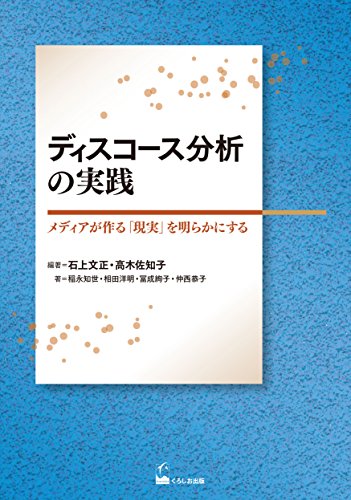28 0 0 0 OA ブッシュ大統領の「同時多発テロ」演説のフレーム分析
- 著者
- 石上 文正
- 出版者
- 人間環境大学
- 雑誌
- こころとことば = Mind and language (ISSN:13472895)
- 巻号頁・発行日
- no.1, pp.1-30, 2002-03-31
2001年9月11日の惨事に関わるブッシュ大統領の演説のフレーム分析を行った。とくに戦争に関する演説にしばしば活性化する二項対立フレームがいつ確立し、どのように変容したかを明らかにした。早くも惨事の夜に受け身型二項対立フレームが確立し、翌日にはさまざまな再定義が行われ、攻撃型二項対立フレームも確立した。また対立する二項には抽象化・拡大化・具体化・微細化等のさまざまな操作が加えられ、世界はさまざまなレベルで二分され、その対立が際だたされた。このテクストの分析から見る限り、惨事の翌日には軍事行動を決意したことがうかがえる。
17 0 0 0 OA 宮崎アニメにみる「窪地」の意味
- 著者
- 石上 文正
- 出版者
- 人間環境大学
- 雑誌
- こころとことば (ISSN:13472895)
- 巻号頁・発行日
- vol.8, pp.1-26, 2009-03-31
「ある程度閉鎖性をもった、人に安らぎを与えてくれる物理的・意味論的空間」を「窪地」と定義し、宮崎駿が製作した8本のアニメ映画にみられる「窪地」の意味を考察し、その結果、つぎの10の意味を析出した。1<子宮>、2<生命(死と再生、治癒・治療)>、3<聖域>、4<シェルター>、5<休息>、6<暖かさ>、7<ふるさと・基地>、8<一体化>、9<自己回帰>、10<秘密>。さらにこれらの意味を考察して、宮崎アニメの「窪地」は、水と樹木と深く関わっていることを明らかにした。「窪地」と水と樹木は、ユング心理学では、母親元型の形態であるとされている。宮崎は、それらのアニメ映画で、直接的には「母」を描いていないが、象徴的に描いていると考えられる。この"矛盾"にこそ、宮崎アニメの本質があるのかもしれない。そして、その「母なる」風景とそこに点在する「窪地」は、私たちの存在とも深く関わっている。
- 著者
- 石上 文正
- 出版者
- 人間環境大学
- 雑誌
- 人間と環境 電子版 (ISSN:21858373)
- 巻号頁・発行日
- vol.9, pp.1-22, 2015-03-31
映画「男はつらいよ」シリーズの劇中において映画のタイトルが表示されるときの口上、「わたくし、生まれも育ちも葛飾柴又です。帝釈天で産湯を使い、姓は車、名は寅次郎、人呼んでフーテンの寅と発します。」および寅さんが生きている社会・世界をN. フェアクラフの批判的ディスコース分析と社会分析を用いて考察する。批判的ディスコース分析から、寅さんの口上には多くの矛盾が認められ、彼が両義的人間であるという結論に至った。また、社会分析によっても彼が生きている世界は両義的世界であることが判明した。その結果、次の2 点が導かれる。(1)この映画では矛盾がさまざまな局面に存在することが、緻密にそして整合的に製作されている、(2)フェアクラフ理論は、社会とことばの分析において、今回のケースでは有効であった。寅さんおよび彼が生きている世界と同様に、現実の世界も矛盾や両義性に満ちていている。いっぽう、フェアクラフ理論の基本は、世界の整合性に基づいている。では、何故フェアクラフ理論が有効であったのだろうか。それは、整合性に基礎を置いている理論だからこそ、矛盾や両義性を検出しやすいのである
2 0 0 0 OA 宮崎アニメにおける制作された<世界>
- 著者
- 石上 文正
- 出版者
- 人間環境大学
- 雑誌
- こころとことば (ISSN:13472895)
- 巻号頁・発行日
- vol.9, pp.1-14, 2010-03-31
宮崎アニメの代表的な9作品を構造的に分析し、どのようなく世界>が制作されているかを明らかにした。その結果、 6つの特徴が得られた(1)「基準牡界」の設定が一作ごとに異なっている。(2)各作品において、基本的には、<現実世界>と<異世界>が制作されている。しかし、それらの<世界>の様相はさまざまで、一作ごとに異なっている。(3)さまざまな<世界>の制作ばかりでなく、<世界>同士の関係も複雑である。(4)さまざまな世界の制作が可能になったのは、魔法、異類、空飛ぶ機械等の不思議な事物が、「基準」として設定されているためであると考えられる。(5)二つの<世界>が対立的な場合には、しばしば、仲介者・仲裁者が登場する。(6)宮崎は、当然視されている分類体系に疑問符を投げかけている。
2 0 0 0 結合による世界の構築 安倍首相の追悼式参列記事の分析
- 著者
- 石上文正
- 出版者
- 人間環境大学
- 雑誌
- 人間と環境 電子版 (ISSN:21858373)
- 巻号頁・発行日
- vol.11, pp.1-16, 2016-03-31
2015 年6 月23 日、安倍晋三首相は、「戦後70 年沖縄全戦没者追悼式」に参列した。この行事を扱った英国のThe Guardian の記事を、「節合」ではなく「結合」という概念を用いて分析した。その結果、この記事の主たるテーマは、安倍首相・政権への批判であり、その理由・原因の第一は、平和憲法の解釈の変更を伴う安保法案制定の動きであり、第2 は、基地の過重負担とそれと深く関わっている基地移設問題であることが判明した。安倍首相への批判に併せて、安倍首相のイメージを悪化させるためのさまざまな手段(たとえば、安倍首相への戦争イメージの付与)が用いられている。同記事の最後に「性奴隷もしくは慰安婦」に関するトピックが結合されていて、「節合」概念を考えるために、この結合が「必然的」なものか「非必然的」なものかについても議論した。
- 著者
- 石上 文正
- 出版者
- 河原学園 人間環境大学
- 雑誌
- 人間と環境 電子版 (ISSN:21858373)
- 巻号頁・発行日
- vol.9, pp.1-22, 2015-03-31 (Released:2018-04-23)
映画「男はつらいよ」シリーズの劇中において映画のタイトルが表示されるときの口上、「わたくし、生まれも育ちも葛飾柴又です。帝釈天で産湯を使い、姓は車、名は寅次郎、人呼んでフーテンの寅と発します。」および寅さんが生きている社会・世界をN. フェアクラフの批判的ディスコース分析と社会分析を用いて考察する。批判的ディスコース分析から、寅さんの口上には多くの矛盾が認められ、彼が両義的人間であるという結論に至った。また、社会分析によっても彼が生きている世界は両義的世界であることが判明した。その結果、次の2 点が導かれる。(1)この映画では矛盾がさまざまな局面に存在することが、緻密にそして整合的に製作されている、(2)フェアクラフ理論は、社会とことばの分析において、今回のケースでは有効であった。寅さんおよび彼が生きている世界と同様に、現実の世界も矛盾や両義性に満ちていている。いっぽう、フェアクラフ理論の基本は、世界の整合性に基づいている。では、何故フェアクラフ理論が有効であったのだろうか。それは、整合性に基礎を置いている理論だからこそ、矛盾や両義性を検出しやすいのである
1 0 0 0 OA 「環境」の定義について
- 著者
- 石上 文正
- 出版者
- 河原学園 人間環境大学
- 雑誌
- 人間と環境 電子版 (ISSN:21858373)
- 巻号頁・発行日
- vol.1, pp.1-19, 2011-02-28 (Released:2018-04-23)
- 被引用文献数
- 1
「環境」および "environment" の定義について考えることによって、人間、環境およびその関係にまつわる考え方や世界観について考察した。まず、基本的な辞書、百科事典で、「環境」および"environment"の定義について調べ、その定義を構成している一般的な 要素を見出した。[1]環境と生命体は二項関係として位置づけられている、[2]環境は空間的概念である、[3]環境と生命体の間には作用関係がある、[4]環境は自然的環境と社会的環境に分けられる、[5]環境は複合的で全体として作用する。次に、「人間環境宣言」および環境心理学(とくに、Interactional World ViewsとTransactionalWorld Views)において、環境概念に、上記の 要素が見出せるか否か、さらには、辞書や百科事典とは異なった考え方があるや否について検討を加えた。最後に、環境と生命体を二項関係として捉えない、いくつかの考え方を示した。
1 0 0 0 ブッシュ大統領の「同時多発テロ」演説のフレーム分析
- 著者
- 石上 文正
- 出版者
- 人間環境大学
- 雑誌
- こころとことば (ISSN:13472895)
- 巻号頁・発行日
- vol.1, pp.1-30, 2002-03-31
2001年9月11日の惨事に関わるブッシュ大統領の演説のフレーム分析を行った。とくに戦争に関する演説にしばしば活性化する二項対立フレームがいつ確立し、どのように変容したかを明らかにした。早くも惨事の夜に受け身型二項対立フレームが確立し、翌日にはさまざまな再定義が行われ、攻撃型二項対立フレームも確立した。また対立する二項には抽象化・拡大化・具体化・微細化等のさまざまな操作が加えられ、世界はさまざまなレベルで二分され、その対立が際だたされた。このテクストの分析から見る限り、惨事の翌日には軍事行動を決意したことがうかがえる。
1 0 0 0 ディスコース分析の実践 : メディアが作る「現実」を明らかにする
- 著者
- 石上文正 高木佐知子編著 稲永知世 [ほか] 著
- 出版者
- くろしお出版
- 巻号頁・発行日
- 2016
1 0 0 0 IR 岡崎市のイメージ
- 著者
- 石上 文正
- 出版者
- 人間環境大学
- 雑誌
- こころとことば = Mind and language (ISSN:13472895)
- 巻号頁・発行日
- no.2, pp.1-24, 2003-03-31
ケヴィン・リンチが『都市のイメージ』で用いた概念、とくにアイデンティティ、ストラクチャー、ミーニングの三つの成分、そしてパス、エッジ、ディストリクト、ノード、ランドマークの五つのエレメントを用いて、愛知県岡崎市の中心市街地の明瞭さや分かりやすさについて記述・分析した。その過程で、ブリッジ(何らかの障害物を渡るためのもの)とマス(丘のような線状でない障害物)という新たなエレメントを抽出した。さらにスキーマという認知心理学的視点からの分析の必要性も説いた。その結果、岡崎は比較的分かりやすい都市であると言える。パスとエッジが岡崎のイメージを構造化するのに大きな役割を果たしている。さらに、特色あるディストリクトも近接して構造化されていて、分かりやすい。ただし、中心市街地の南部と北部が曖昧で、少し分かりにくい。また、南と北ほどではないが、東の構造化も十分ではない。This study investigates the image of Okazaki City, especially its central area, in terms of clarity or legibility. It looks at the image of the city in terms of Kevin Lynch's five elements -paths, edges, districts, nodes and landmarks- and three components of each element: identity, structure, meaning. Bridges and masses are also necessary to describe the image of Okazaki. The former includes ordinary bridges and tunnels crossing edges. Masses refers to hills and lakes that can keep people from passing through. It is also argued that schema, a cognitive psychological concept, plays an important role in constructing the image of cities including Okazaki. This study concludes that Okazaki is legible as a whole because it is well-structured by paths and edges. Paths and edges also mark conspicuous districts such as Kosei (a commercial district), Okazaki-koen (a historical district) and Tatsumigaoka (a religious-educational district). The north and south parts of Okazaki, however, are ambiguous and not legible because no clear paths and edges run north and south.
1 0 0 0 OA Intelligent Designにおける科学という"イデオロギー"
- 著者
- 石上 文正
- 出版者
- 人間環境大学
- 雑誌
- こころとことば (ISSN:13472895)
- 巻号頁・発行日
- vol.6, pp.1-14, 2007-03-31
この小論では、批判的談話分析の手法、とくにNorman Faircloughの手法を、科学哲学者Stephen C.Meyerのintelligent designに関するエッセーに応用し、分析を試みた。Faircloughは、ディスコースの中の「常識」や「前提」を「イデオロギー」と考えている。Meyerのエッセーには、"evidence"と"explain"という「科学性」を示す言葉が当然のごとく、しばしば用いられている。このことから、同エッセーは、科学イデオロギーの強い影響をうけた、科学的ディスコースであることが明らかになる。つまり、「科学」が「イデオロギー」として機能していると考えられる。さらに、同エッセーを科学的ディスコースに作り上げている手法について考察し、同ディスコースの議論構造、最先端の科学的知識の提示、著名な科学者の引用、科学的比喩の使用、"know"という叙実的動詞を用いた事実的前提の提示などを指摘した。



